Tuesday, July 20, 2004
Pass the sunblock
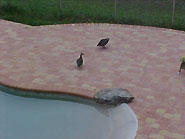 Where else but in Florida would there be ducks sitting by the pool soaking in the sun. My husband and I were working in the office and about mid-day decided, through the urging of Duncan, that it was time to take the boys out for their usual afternoon rounds. As I stood up I noticed two ducks having the time of their life preening by our pool. My husband and I stood and watched them for a good five minutes before they decided they had had enough and were ready to go home for lunch. No wonder our littliest guy had decided he really really needed to go out.
Where else but in Florida would there be ducks sitting by the pool soaking in the sun. My husband and I were working in the office and about mid-day decided, through the urging of Duncan, that it was time to take the boys out for their usual afternoon rounds. As I stood up I noticed two ducks having the time of their life preening by our pool. My husband and I stood and watched them for a good five minutes before they decided they had had enough and were ready to go home for lunch. No wonder our littliest guy had decided he really really needed to go out. 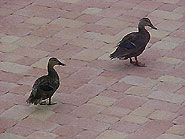 He saw the ducks and wanted them out of his yard! He sure was disappointed when he ran out barking and they were nowhere to be found. Duncan sniffed and snorted, and finally settled on barking at them as they walked around in the neighbor's yard across the pond. He had done his job, you see, in getting those wild marauding ducks away from his home and family. All was well in his little view of the world. Happy Florida Gardening.
He saw the ducks and wanted them out of his yard! He sure was disappointed when he ran out barking and they were nowhere to be found. Duncan sniffed and snorted, and finally settled on barking at them as they walked around in the neighbor's yard across the pond. He had done his job, you see, in getting those wild marauding ducks away from his home and family. All was well in his little view of the world. Happy Florida Gardening.
Monday, July 12, 2004
Cardboard or leather?
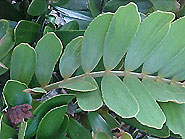 I had heard this plant is a cardboard palm. Then someone else told me it was a leather fern. Which to believe? I did my usual search and found out. It's cardboard, hands down! Cardboard palm is an interesting plant originating on the east coast of Mexico. It is a slow grower, reaching about 4 feet in height and width. Known by its latin name, Zamia furfuracea, the plant does well in light shade. I actually have six in my side garden that were covered over by the winged elm tree I mentioned not too long ago. After we scalped the tree and pulled all the weeds, I proceeded to clip all the old leaves on the cardboard palms hoping to help spur its growth. It worked because all now have new leaves forming or so I would like to think.
I had heard this plant is a cardboard palm. Then someone else told me it was a leather fern. Which to believe? I did my usual search and found out. It's cardboard, hands down! Cardboard palm is an interesting plant originating on the east coast of Mexico. It is a slow grower, reaching about 4 feet in height and width. Known by its latin name, Zamia furfuracea, the plant does well in light shade. I actually have six in my side garden that were covered over by the winged elm tree I mentioned not too long ago. After we scalped the tree and pulled all the weeds, I proceeded to clip all the old leaves on the cardboard palms hoping to help spur its growth. It worked because all now have new leaves forming or so I would like to think.
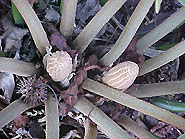 The cardboard palm is not actually a palm but a cycad. All that means is that it forms a cone in the center of its leaf growth where its seed is stored. From everything I've read, apparently the cardboard palm hails back to prehistoric days and is considered a "living fossil" plant. Specifically, the Jurassic period is known as the "age of cycads", which includes our friend the zamia. You get it all here - plant information and a history lesson all in one. What more could you ask for? Happy Florida Gardening.
The cardboard palm is not actually a palm but a cycad. All that means is that it forms a cone in the center of its leaf growth where its seed is stored. From everything I've read, apparently the cardboard palm hails back to prehistoric days and is considered a "living fossil" plant. Specifically, the Jurassic period is known as the "age of cycads", which includes our friend the zamia. You get it all here - plant information and a history lesson all in one. What more could you ask for? Happy Florida Gardening. Sunday, July 04, 2004
Wedelia trilobata--creeping daisy
I bought a book about 6 years ago because I thought the price was right and I was excited by the advance info included in the advertisement. When it arrived, I glanced through it and placed it on the shelf with my other garden books thinking maybe it wasn't the bargain I had anticipated. It contained some good information about plants, and included a plant selection guide with some color pics. But the majority of plant specifics was in paragraph form with black and white drawings that are not necessarily true to exact form, in my opinion. Over the years I have periodically referred to the book when trying to determine a specific species of plant but usually found what I was looking for in other reference books. So today, stymied by a particular ground cover I just could not identify, I grabbed this book and actually found the plant after confirming through some additional web research. Wedelia trilobata is a perennial ground cover that pretty much roots wherever it wants. It is tolerant of heat, drought and salt and that is why it does so well in the corner of our back yard. It is pretty and is actually a member of the aster family; I like asters, but this is pretty daggone invasive. The good news is that it pulls up very easily - the bad news is that it replenishes itself quickly. I have found the best control is the lawn mower. You know, the one my dad gave me although I'm sure any lawn mower could do the trick.
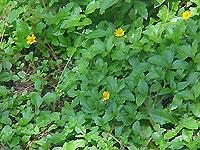 I looked at a few references on the net and found it is apparently extremely invasive in Australia and French Polynesia. In fact, it is so worrisome they are tracking the plant and determining ways to chemically eradicate it. As the old saying goes, "one person's trash is another's treasure" but I can understand their concern. Anyway, I think I have this creeper under control (famous last words)and it sure is pretty in the corner where it resides. I pull handsful of it out every so often and of course run it over with the mower every two weeks whether it needs it or not. I'm just so happy to finally know what's growing here. Oh, the book I found it in? The Southern Living Garden Book. It bills itself as the complete encyclopedia of more than 5,000 southern plants and it probably does list that many. It really does contain a lot of good reference material. The part I don't care for is the pictures in the front of some private gardens containing no plant identification and, as I mentioned, the lack of good, clear illustrations. Anyway, it helped me nail down what I needed so I'll give it the credit it's due. And I'll keep an eye on the creeping daisy and make sure it doesn't start spreading toward our pals in Australia from this yard. Happy Florida Gardening.
I looked at a few references on the net and found it is apparently extremely invasive in Australia and French Polynesia. In fact, it is so worrisome they are tracking the plant and determining ways to chemically eradicate it. As the old saying goes, "one person's trash is another's treasure" but I can understand their concern. Anyway, I think I have this creeper under control (famous last words)and it sure is pretty in the corner where it resides. I pull handsful of it out every so often and of course run it over with the mower every two weeks whether it needs it or not. I'm just so happy to finally know what's growing here. Oh, the book I found it in? The Southern Living Garden Book. It bills itself as the complete encyclopedia of more than 5,000 southern plants and it probably does list that many. It really does contain a lot of good reference material. The part I don't care for is the pictures in the front of some private gardens containing no plant identification and, as I mentioned, the lack of good, clear illustrations. Anyway, it helped me nail down what I needed so I'll give it the credit it's due. And I'll keep an eye on the creeping daisy and make sure it doesn't start spreading toward our pals in Australia from this yard. Happy Florida Gardening.
 I looked at a few references on the net and found it is apparently extremely invasive in Australia and French Polynesia. In fact, it is so worrisome they are tracking the plant and determining ways to chemically eradicate it. As the old saying goes, "one person's trash is another's treasure" but I can understand their concern. Anyway, I think I have this creeper under control (famous last words)and it sure is pretty in the corner where it resides. I pull handsful of it out every so often and of course run it over with the mower every two weeks whether it needs it or not. I'm just so happy to finally know what's growing here. Oh, the book I found it in? The Southern Living Garden Book. It bills itself as the complete encyclopedia of more than 5,000 southern plants and it probably does list that many. It really does contain a lot of good reference material. The part I don't care for is the pictures in the front of some private gardens containing no plant identification and, as I mentioned, the lack of good, clear illustrations. Anyway, it helped me nail down what I needed so I'll give it the credit it's due. And I'll keep an eye on the creeping daisy and make sure it doesn't start spreading toward our pals in Australia from this yard. Happy Florida Gardening.
I looked at a few references on the net and found it is apparently extremely invasive in Australia and French Polynesia. In fact, it is so worrisome they are tracking the plant and determining ways to chemically eradicate it. As the old saying goes, "one person's trash is another's treasure" but I can understand their concern. Anyway, I think I have this creeper under control (famous last words)and it sure is pretty in the corner where it resides. I pull handsful of it out every so often and of course run it over with the mower every two weeks whether it needs it or not. I'm just so happy to finally know what's growing here. Oh, the book I found it in? The Southern Living Garden Book. It bills itself as the complete encyclopedia of more than 5,000 southern plants and it probably does list that many. It really does contain a lot of good reference material. The part I don't care for is the pictures in the front of some private gardens containing no plant identification and, as I mentioned, the lack of good, clear illustrations. Anyway, it helped me nail down what I needed so I'll give it the credit it's due. And I'll keep an eye on the creeping daisy and make sure it doesn't start spreading toward our pals in Australia from this yard. Happy Florida Gardening. Thursday, July 01, 2004
Castor bean plant is gone
Just an update. The castor bean plant is now gone. We dug it up this morning. Luckily it had only one smallish tap root with lots of little thread roots so was easy to remove. No castor bean plants around here!

This work is licensed under a Creative Commons License.
Thanks to Andrew Stenning who contributed the photograph for our masthead


